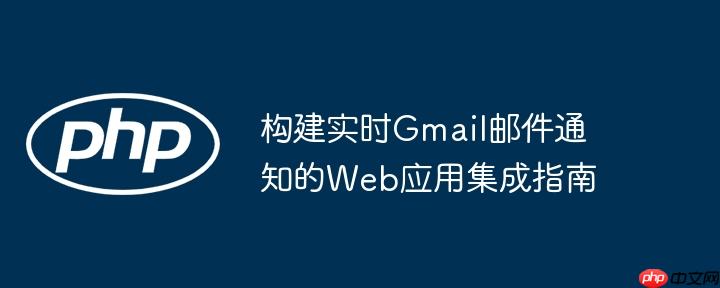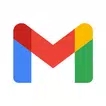
引言:Web应用中实时邮件通知的重要性
在现代Web应用中,为用户提供即时反馈和最新信息至关重要。当用户需要在其Web应用中接收到Gmail账户新邮件的实时通知时,传统的数据拉取(Polling)方式往往效率低下且延迟较高。实现这一功能的核心在于如何高效、准确地感知到Gmail邮箱的变化,并将其推送至Web应用。
IMAP的局限性分析
IMAP(Internet Message Access Protocol)是一种邮件访问协议,允许客户端从邮件服务器上管理和检索邮件。尽管IMAP可以用于获取邮件,但在实现Web应用实时通知方面存在显著局限性:
- 拉取(Polling)模式: IMAP本质上是一种拉取协议,客户端需要周期性地连接服务器,查询是否有新邮件。这种轮询机制不仅消耗服务器资源,而且无法实现真正的实时通知,总是存在一定的延迟。
- 时间戳查询精度: 许多IMAP库在进行时间戳查询时,可能只能精确到日期级别,难以实现“某年某月某日某时某分之后”的精确查询。例如,SEARCH SINCE "11-Oct-2021" 可能会返回自该日期开始的所有邮件,而不是特定时间点之后的邮件。
- UID的挑战: 虽然IMAP支持基于UID(Unique Identifier)的邮件查询,但要持续跟踪最新UID并只拉取新邮件,需要客户端维护状态,并在每次轮询时进行比较,这增加了实现的复杂性和出错的概率。
- 非推送特性: IMAP本身不提供服务器向客户端主动推送消息的能力,因此无法满足Web应用对实时通知的需求。
鉴于以上局限性,IMAP并非实现Web应用实时Gmail通知的最佳选择。
核心方案:Gmail API结合Google Cloud Pub/Sub实现推送通知
为了克服IMAP的局限性,Google提供了Gmail API,并结合Google Cloud Pub/Sub(发布/订阅)服务,为开发者提供了强大的实时推送通知能力。这种方案能够让Web应用在Gmail邮箱发生变化(如收到新邮件)时,几乎即时地接收到通知。
1. 方案概述
Gmail API允许开发者以编程方式访问和管理Gmail数据。通过users.watch方法,开发者可以订阅特定Gmail邮箱的变更事件,并将这些事件通知发送到一个Google Cloud Pub/Sub主题。一旦Pub/Sub主题收到消息,它会立即将其推送到预先配置的Web应用Webhook端点,从而实现实时通知。
2. 工作流程详解
实现此方案的典型步骤如下:
2.1 OAuth 2.0 认证
Web应用需要获得用户授权才能访问其Gmail数据。这通过Google OAuth 2.0 流程实现。用户首次使用时,会被重定向到Google的授权页面,同意应用访问其Gmail账户(通常需要https://www.googleapis.com/auth/gmail.readonly或更高级别的权限,取决于后续操作)。授权成功后,应用将获得访问令牌和刷新令牌,用于后续的API调用。
2.2 启用相关API
在Google Cloud Console中,确保你的项目已启用以下API:
- Gmail API
- Cloud Pub/Sub API
2.3 创建Pub/Sub主题与订阅
在Google Cloud Console中,创建一个Pub/Sub主题(Topic)和一个订阅(Subscription)。

华友协同办公管理系统(华友OA),基于微软最新的.net 2.0平台和SQL Server数据库,集成强大的Ajax技术,采用多层分布式架构,实现统一办公平台,功能强大、价格便宜,是适用于企事业单位的通用型网络协同办公系统。 系统秉承协同办公的思想,集成即时通讯、日记管理、通知管理、邮件管理、新闻、考勤管理、短信管理、个人文件柜、日程安排、工作计划、工作日清、通讯录、公文流转、论坛、在线调查、
- 主题(Topic): 邮件变更通知将首先发送到这个主题。例如,命名为 gmail-notifications。
- 订阅(Subscription): 订阅用于从主题中拉取或接收消息。选择“推送(Push)”类型,并指定你的Web应用中用于接收通知的Webhook URL。
2.4 配置Gmail API推送通知
使用Gmail API的users.watch方法,配置用户的Gmail邮箱,使其将变更通知发送到你创建的Pub/Sub主题。你需要提供一个Pub/Sub主题名称,以及可选的标签(labelIds)来过滤通知。
示例(使用Google API客户端库):
# 假设你已经通过OAuth获取了凭据 (credentials)
from google.oauth2.credentials import Credentials
from googleapiclient.discovery import build
# 构建Gmail服务客户端
service = build('gmail', 'v1', credentials=credentials)
# Pub/Sub 主题名称,格式为 projects/YOUR_PROJECT_ID/topics/YOUR_TOPIC_NAME
# 替换 YOUR_PROJECT_ID 和 YOUR_TOPIC_NAME
topic_name = 'projects/your-gcp-project-id/topics/gmail-notifications'
# 配置watch请求体
watch_request = {
'topicName': topic_name,
# 'labelIds': ['INBOX'] # 可选:只监听收件箱的变更
}
try:
# 调用users.watch方法
response = service.users().watch(userId='me', body=watch_request).execute()
print(f"Gmail watch setup successful. History ID: {response.get('historyId')}")
except Exception as e:
print(f"Error setting up Gmail watch: {e}")users.watch方法会返回一个historyId。这个historyId是当前邮箱状态的一个快照,后续接收到的通知会包含一个historyId范围,你可以用它来获取自上次通知以来发生的所有变更。
2.5 设置Webhook端点
在你的Web应用(如CodeIgniter应用)中,创建一个公开可访问的HTTP POST端点,用于接收来自Google Cloud Pub/Sub的推送消息。
CodeIgniter 伪代码示例:
// app/Controllers/Webhook.php
namespace App\Controllers;
use CodeIgniter\Controller;
use CodeIgniter\HTTP\ResponseInterface;
class Webhook extends Controller
{
public function gmail()
{
// 验证请求是否来自Google Pub/Sub (可选但强烈推荐)
// 可以通过验证请求头中的 'X-Goog-Signature' 或其他机制
$input = $this->request->getRawInput();
$data = json_decode($input, true);
// Pub/Sub消息体通常包含一个'message'字段
if (isset($data['message']['data'])) {
$message_data = base64_decode($data['message']['data']);
$notification = json_decode($message_data, true);
// 检查通知类型,通常是关于邮件历史ID的变更
if (isset($notification['emailAddress']) && isset($notification['historyId'])) {
$email_address = $notification['emailAddress'];
$new_history_id = $notification['historyId'];
// 这里是处理通知的核心逻辑
// 你需要:
// 1. 获取该用户之前存储的 historyId
// 2. 调用 Gmail API 的 users.history.list 方法,传入 startHistoryId
// 来获取所有自上次同步以来的变更(包括新邮件)
// 3. 遍历变更列表,识别新邮件,并进行相应处理(如存储、发送应用内通知)
log_message('info', "Received Gmail notification for {$email_address}. New historyId: {$new_history_id}");
// 示例:获取历史变更
$this->processGmailHistory($email_address, $new_history_id);
return $this->response->setStatusCode(ResponseInterface::HTTP_OK);
}
}
// 如果消息格式不正确或处理失败,返回非2xx状态码,Pub/Sub会重试
return $this->response->setStatusCode(ResponseInterface::HTTP_BAD_REQUEST);
}
private function processGmailHistory(string $emailAddress, string $newHistoryId)
{
// 实际应用中,你需要从数据库中获取该用户上一次处理的 historyId
// 这里假设我们有一个函数来获取用户的凭据和上一次的 historyId
$user_credentials = $this->getUserCredentials($emailAddress); // 你的逻辑
$last_processed_history_id = $this->getLastProcessedHistoryId($emailAddress); // 你的逻辑
if (!$user_credentials || !$last_processed_history_id) {
log_message('error', "Could not retrieve credentials or last history ID for {$emailAddress}");
return;
}
$service = build('gmail', 'v1', credentials=$user_credentials);
try {
$history_response = $service->users()->history()->list(
userId='me',
startHistoryId=$last_processed_history_id,
historyTypes=['messageAdded'] // 只关注消息添加事件
)->execute();
$history_items = $history_response->get('history', []);
foreach ($history_items as $history_item) {
if (isset($history_item['messagesAdded'])) {
foreach ($history_item['messagesAdded'] as $message_added) {
$message_id = $message_added['message']['id'];
// 获取新邮件的详细信息
$message = $service->users()->messages()->get(userId='me', id=$message_id).execute();
log_message('info', "New mail received: " . $message['snippet']);
// 在这里触发Web应用内的通知逻辑
}
}
}
// 更新用户存储的 historyId 为新的 historyId
$this->updateLastProcessedHistoryId($emailAddress, $newHistoryId); // 你的逻辑
} catch (Exception $e) {
log_message('error', "Error processing Gmail history for {$emailAddress}: {$e->getMessage()}");
}
}
// 辅助函数,需要根据你的应用实际实现
private function getUserCredentials(string $emailAddress) { /* ... */ return null; }
private function getLastProcessedHistoryId(string $emailAddress) { /* ... */ return 'YOUR_INITIAL_HISTORY_ID'; } // 首次设置时需存储
private function updateLastProcessedHistoryId(string $emailAddress, string $newHistoryId) { /* ... */ }
}2.6 处理Pub/Sub消息与获取最新邮件
当Webhook端点接收到Pub/Sub消息时,消息体通常包含Base64编码的JSON数据。解码后,你会得到一个包含emailAddress和historyId的通知对象。historyId是关键,它代表了当前邮箱的最新状态。
为了获取自上次通知以来发生的所有变更(包括新邮件),你需要:
- 存储historyId: 为每个用户维护一个上次成功处理的historyId。
- 调用users.history.list: 使用Gmail API的users.history.list方法,传入之前存储的startHistoryId。这将返回从startHistoryId到当前historyId之间的所有历史变更。
- 识别新邮件: 遍历返回的历史变更列表,查找messagesAdded类型的事件,这些事件包含了新邮件的ID。
- 获取邮件详情: 根据新邮件的ID,调用users.messages.get方法获取邮件的详细内容(包括发件人、主题、正文摘要等),然后触发Web应用内的通知机制。
3. 优势
- 实时性: 基于推送机制,几乎能即时响应邮件变更。
- 高效性: 避免了频繁的轮询,大大节省了服务器资源和API配额。
- 可伸缩性: Google Cloud Pub/Sub本身具有高可用和高伸缩性,能够处理大量并发通知。
- 精确性: historyId机制保证了能够精确地获取自上次同步以来的所有变更,避免遗漏或重复。
注意事项与最佳实践
-
安全性:
- Webhook验证: 强烈建议验证传入Webhook请求的来源,确保其确实来自Google Pub/Sub。可以通过验证X-Goog-Signature请求头或使用其他安全措施。
- OAuth凭据安全: 用户的OAuth刷新令牌和访问令牌应安全地存储在后端数据库中,并进行加密。
- 权限最小化: 仅申请应用所需的最小Gmail API权限(如gmail.readonly)。
-
错误处理与重试:
- Pub/Sub默认提供“至少一次(At-least-once)”的消息投递保证。这意味着你的Webhook端点可能会收到重复的消息。因此,处理逻辑需要具备幂等性。
- 如果Webhook端点返回非2xx的HTTP状态码(如500),Pub/Sub会认为消息未成功处理,并会在稍后重试投递。确保你的错误处理逻辑能够正确返回状态码。
-
资源管理:
- Gmail API的users.watch方法设置的通知有效期为7天。你需要定期(例如,每隔几天)调用users.watch来刷新订阅,以确保通知服务持续有效。
-
CodeIgniter集成考量:
- Google API客户端库: 在CodeIgniter项目中,可以通过Composer安装Google API PHP Client库。
- OAuth流程: 实现OAuth授权回调路由和逻辑,安全存储用户凭据。
- Webhook控制器: 创建专门的控制器(如Webhook.php)来处理Pub/Sub推送的请求。
- 数据库集成: 维护一个用户表,存储用户的Gmail地址、OAuth刷新令牌以及上次处理的historyId。
总结
在Web应用中实现Gmail新邮件的实时通知,最佳实践是利用Google Gmail API结合Google Cloud Pub/Sub服务。这种方案克服了传统IMAP轮询的局限性,通过推送机制实现了高效、低延迟的通知。开发者需要妥善处理OAuth认证、Pub/Sub配置、Webhook端点接收和处理,以及后续的Gmail API调用来获取邮件详情。遵循上述指南和最佳实践,将能够为用户提供卓越的实时邮件通知体验,同时优化系统资源利用。






























